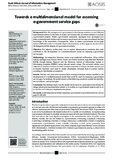Please use this identifier to cite or link to this item:
https://cris.library.msu.ac.zw//handle/11408/4080Full metadata record
| DC Field | Value | Language |
|---|---|---|
| dc.contributor.author | Mahlangu, Gilbert | - |
| dc.contributor.author | Ruhode, Ephias | - |
| dc.date.accessioned | 2020-12-17T14:01:09Z | - |
| dc.date.available | 2020-12-17T14:01:09Z | - |
| dc.date.issued | 2020-12 | - |
| dc.identifier.issn | 1560-683X | - |
| dc.identifier.uri | https://sajim.co.za/index.php/sajim/article/view/1234 | - |
| dc.identifier.uri | http://hdl.handle.net/11408/4080 | - |
| dc.description.abstract | The term e-government is generally understood to mean the use of information technologies such as wide area networks, the Internet and mobile computing by government agencies to relate with citizens, businesses and other arms of government (Ngonzi & Sewchurran 2019). E-government is one of the foundations in the transformation drive of public service delivery. By implementing e-government, the majority of public services are expected to be provided electronically. The areas that have shown the most significant progress in the transformation drive of public service delivery include, but are not limited to, e-procurement; e-invoicing; e-payment; e-licensing; e-archiving; e-tendering; e-taxation; e-voting; e-democracy; e-submission; e-rental; e-compliance; e-assessment; e-participation; e-visa; e-health; e-learning; e-court; online passports, birth registration and permits applications; and online company registration (Baheer, Lamas & Samas 2020; Mukamurenzi, Grönlund & Islam 2019). Indeed, e-government is playing a critical role in transforming public services. Accordingly, the transformation drive in public service is facilitated by the following e-government delivery models: Government-to-Government (G2G); Government-to-Employees (G2E); Government-to-Business (G2B); and Government-to-Citizens (G2C) (Ahmad et al. 2019; Ramdan, Azizan & Saadan 2014; Voutinioti 2014). G2G represents the backbone platform for e-government adoption, implementation and utilisation in the entire country (Voutinioti 2014); G2E represents an internal relationship between the government and its employees (Ramdan et al. 2014); | en_US |
| dc.language.iso | en | en_US |
| dc.publisher | South African Journal of Information Management | en_US |
| dc.relation.ispartofseries | Vol 22, No 1; | - |
| dc.subject | multi-dimensional model | en_US |
| dc.subject | assessing e-government | en_US |
| dc.subject | e-government service | en_US |
| dc.subject | service gaps | en_US |
| dc.subject | E-GSGAM | en_US |
| dc.title | Towards a multidimensional model for assessing e-government service gaps | en_US |
| dc.type | Thesis | en_US |
| item.openairecristype | http://purl.org/coar/resource_type/c_18cf | - |
| item.grantfulltext | open | - |
| item.cerifentitytype | Publications | - |
| item.languageiso639-1 | en | - |
| item.fulltext | With Fulltext | - |
| item.openairetype | Thesis | - |
| Appears in Collections: | Research Papers | |
Files in This Item:
| File | Description | Size | Format | |
|---|---|---|---|---|
| towards.pdf | Full Text | 647.84 kB | Adobe PDF |  View/Open |
Page view(s)
44
checked on Jul 25, 2024
Download(s)
16
checked on Jul 25, 2024
Google ScholarTM
Check
Items in MSUIR are protected by copyright, with all rights reserved, unless otherwise indicated.



